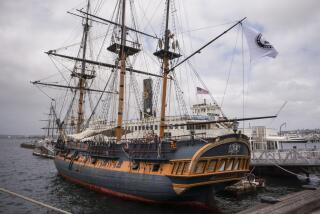Small ships return big rewards, cruisers say
- Share via
The sun was smoldering on the horizon when I boarded Lindblad Expeditions’ new National Geographic Venture. The vessel had sailed into the Port of Long Beach that warm December day on its maiden voyage, and I was able to catch a look before it sailed off into the sunset.
New ships stop occasionally at Southland ports; I visited Norwegian Cruise Line’s Bliss when it stopped last year at the Port of Los Angeles on a maiden cruise.
The two ships are the yin and yang of cruising: Both are beautiful, but they are very different.
Bliss has 20 decks and 2,220 staterooms and can carry 4,000 passengers. A racetrack curves around its top deck, and passengers can dine at eight venues.
Venture has four decks and 50 staterooms and can carry 100 cruisers. Passengers can participate in yoga on the top deck and dine in a single cafeteria on the lower deck.
Despite Venture’s lack of frills, Ken Carlson wouldn’t trade that vessel for a cruise on a mega-ship.
“I’ve tried big ships. I swore I’d never do it again,” said Carlson, a Santa Monica filmmaker who participated in Venture’s maiden voyage.
Robert Cameron, a Venture cruiser from Los Feliz, agreed. “I’m not a fan of big ships,” he said. “I took a cruise to Alaska on a ship with 1,200 people. It’s just not for me. They’re more focused on entertainment and amenities.”
But big ships have fans who are equally devoted and enjoy the entertainment — and the value they offer.
Kathy Hamada became a fan of large ships when 11 members of her family celebrated her parents’ 50th wedding anniversary on a weeklong cruise to Alaska on Holland America Line. Hamada lives in Houston, but the rest of the family is in Southern California.
“It was a great way for us to travel as a group,” she said. “We had a planned mealtime together, but during the day everyone could go off and do what they wanted. My parents liked the casino, and the kids had many diversions to keep them busy.”
Small-ship travel is all about nature, photography and capturing experiential moments in wild places around the world. Lindblad is the granddaddy of this form of travel, having pioneered it a half-century ago.
Chief executive Sven Lindblad was all smiles when I met him on board in December. Venture is the company’s second new build, and he’s proud of the ship.
“It’s comfortable, nimble, and with massive amounts of glass, our guests will constantly be connected to the outside world,” he said. “We are delighted with the way she came out.”
His timing is excellent: Small-ship sailing is growing in popularity, with an increasing number of competitors offering trips to places such as Baja, the Galápagos Islands, Antarctica and Alaska. Hurtigruten and Ponant have beefed up their fleets to appeal to that growing market, and other brands will launch small ships or adventure yachts in the next two years.
Which type of cruising is best for you? Small and large ships offer fundamentally different experiences and attract different types of travelers. Here’s a look at some of the ways they vary:
Prices: Small ships usually are significantly more expensive, often double or triple the price of a larger cruise-ship fare. You probably won’t find the kind of bargains available on megaships: no $500 cruises to Alaska or $300 weekend jaunts to Ensenada, Mexico.
Crowds: On a small ship, you won’t have to wait 10 minutes for an elevator when the evening stage show ends. On the flip side, there won’t be a stage show and the ship may not have an elevator.
Entertainment: Don’t expect orchestras or aerialists on a small ship. You’re more likely to gather each night in the lounge for lectures by naturalists and photo tips.
Dining: A big ship may have more than 10 places to eat and drink; on a small ship there probably will be only a couple. But you may get to go ashore in far-flung places for a bonfire and barbecue on the beach.
Activities: You won’t find climbing walls, mini-golf, laser tag or wave pools on a small ship. In fact, you may not find a pool at all. But you will go snorkeling, hiking and kayaking in beautiful places. Big ships are destinations in themselves; small ships are a means to get to wild destinations.
Ambience: On a big ship, you may not see the same person twice. On a small one, you’re more likely to make friends with people who have similar nature-loving interests.
“It’s like going to camp, making friends and bonding over shared experiences away from the world,” said Cameron, whose 13-day Venture cruise took him to the waters of Mexico’s Baja and included intense whale-watching experiences.
“We were literally eye to eye with humpbacks,” he said. “It was one of the best days of my life.”
More to Read
Sign up for The Wild
We’ll help you find the best places to hike, bike and run, as well as the perfect silent spots for meditation and yoga.
You may occasionally receive promotional content from the Los Angeles Times.






